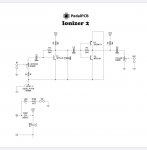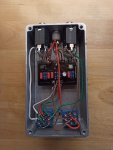Danbieranowski
Well-known member
Hey all,
If anyone could help answer this question, I’d really appreciate it!
In this schematic, what controls the frequency of the oscillation?

I’m assuming it’s the Oscillation pot, but before I go pulling stuff out of the board I want to make sure. The reason I ask is that this is the second one of these I’ve built, and in the first, the oscillation was a much higher register and note than in the second, which sputters at a very low frequency. I’m wondering if I need to swap out a component somewhere that might be restricting that frequency.
Thanks!
Dan
If anyone could help answer this question, I’d really appreciate it!
In this schematic, what controls the frequency of the oscillation?

I’m assuming it’s the Oscillation pot, but before I go pulling stuff out of the board I want to make sure. The reason I ask is that this is the second one of these I’ve built, and in the first, the oscillation was a much higher register and note than in the second, which sputters at a very low frequency. I’m wondering if I need to swap out a component somewhere that might be restricting that frequency.
Thanks!
Dan


